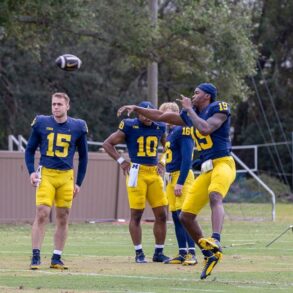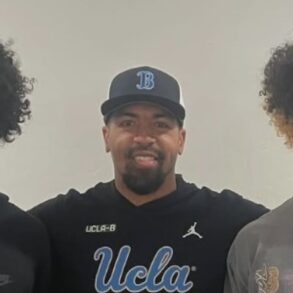
College football personnel staffers spend countless hours studying film, evaluating players from all levels to prepare for the two transfer portal windows. Most of the fireworks occur in December, but there has typically also been a flurry of activity in the spring window, which opens Wednesday and closes on April 25.
Advertisement
What can we expect in the 2025 cycle?
“Usually, by this time, I’ve got a pretty good feel for it,” a Big Ten personnel staffer said. “This year, it doesn’t seem like it’s going to have a whole lot of action.”
A Group of 5 general manager said: “I still think it’s going to be active. It’s like wishful thinking, ‘Oh, it’s not going to be that crazy,’ then it hits and it’s just as crazy as it’s been in the past.”
The Nico Iamaleava saga showed that anything is possible. Last year’s spring portal window was expected to be chaotic but ended up low in drama. In recent weeks, staffers have said this year will be uneventful, and then Iamaleava became one of the most fascinating transfers in recent memory.
“To be honest,” an SEC personnel staffer said, “I think anyone telling you something with conviction is guessing.”
Transfer windows are open for 30 days throughout the academic year — 20 in December and 10 in April. There are exceptions — for players whose season goes beyond the window, coaching changes, graduate transfers, etc. — but for the most part, those are the main opportunities for players to relocate and for teams to add personnel.
The spring portal has taken on a different shape nearly every year. In 2022, a player could enter the portal at any point up until May 1. Then came the introduction of transfer windows in 2023, which was intended to provide some structure. And now, in a seismic change, players are permitted to transfer multiple times without penalty.
This year, there’s the looming aspect of the House settlement, which will introduce revenue sharing and create a roster cap of 105 players.
The Athletic recently spoke to eight personnel staffers across the country to get a sense of the lessons they’ve learned from the past few years of the spring portal window, the mistakes they see programs make and what they expect from the upcoming cycle.
Advertisement
They were granted anonymity for their candor.
Lessons from past spring windows
One common theme has emerged: If you’re active in the spring portal window, you’re probably going to overpay.
The talent available in the spring isn’t as abundant as it is during the winter window. But programs are more desperate because it’s the last opportunity to improve the roster before the season starts. And if you’re a coach who believes adding a player at a position of need may be the difference between winning a conference title or not — or keeping your job or getting fired — why not pay that spring tax? Sometimes, urgency wins out over prudent planning.
“So you’ll see a lot of guys who aren’t as good get a lot more than they should,” a Big 12 recruiting staffer said.
We’ve seen plenty of programs remake their rosters during the winter portal window. It typically happens during coaching transitions. Lincoln Riley did it when he was hired at USC in 2021. Deion Sanders took it to another level at Colorado a year later. Marshall added 47 transfers during the recent winter cycle.
But it’s difficult to replicate that sort of roster movement in the spring. This window is more about building depth and trying to plug a hole here and there — not executing a massive overhaul or filling out several position groups with top-end guys.
“If you’re trying to fill a bunch of starting roles, you’re kind of screwing yourself,” the G5 general manager said. “You use (the spring window) to enhance your roster, but you don’t use it to make your roster competitive.”
Of course, as Iamaleava displayed, the spring portal window is “another opportunity for these kids to negotiate, which is happening this year more than any other year — just because of the increase of money in the game,” said an ACC personnel staffer.
Advertisement
If utilized correctly — which wasn’t the case with Iamaleava — the spring window can give high-end players a significant amount of leverage because they know their program can’t afford to lose them. It can create a tough situation for a coaching staff. In the spring of 2024, defensive lineman Bear Alexander, viewed by many as USC’s best defensive player, was rumored to be entering the transfer portal. USC countered by increasing his NIL deal, and he stayed with the Trojans. To the surprise of few, Alexander didn’t make it through the 2024 season and has since transferred to Oregon.
Ready to wreak havoc. @BearAlexander_ is an Oregon Duck!#GoDucks pic.twitter.com/FswyIsVbTh
— Oregon Football (@oregonfootball) December 28, 2024
“You’ve got to be honest with yourself and especially the guys earlier in the window who want to leave,” an ACC personnel staffer said. “You have to be true to your formulas and processes and be able to live with it at the end of the day, but understanding you might not be able to replace this kid. It’s a tough line to toe for sure.”
That’s exactly what Tennessee did with Iamaleava. The Volunteers clearly did not want to overpay.
Spring portal pitfalls
It’s common to hear coaches or college football observers claim that players don’t stick around to be developed anymore. But it goes both ways.
“If you have a guy in the portal who’s marginal talent, you don’t take that kid and hurt the development of your younger, more talented players,” the G5 general manager said. “I think teams panic and just rush to get whoever they can instead of just making sure the fit is right, not just for their program now, but their program for the future.”
A second Big 12 staffer said: “I think teams undervalue guys on their own roster. We talk all the time about wanting to be a developmental team, work these guys, giving them time to grow up, but sometimes, we don’t give them enough time. You never know when a guy might flip the switch.”
It also doesn’t help when programs look at film from a player’s previous season and expect that same level of play without accounting for the player’s transition to a new program and a new school. It’s difficult to overstate the value coaches put on spring practice.
Advertisement
“When it’s a one-year guy, you only have him five, six months,” the Big Ten personnel staffer said. “That’s just not long enough for most people to really get situated. It’s really not till like halfway through the year or the latter half of the season where they start to find home or comfortability.”
That’s something Iamaleava’s new school and other programs that bring in six-month rentals will have to consider.
“We did a study of everyone we took in the spring (in past years), and I don’t know that any one of them was a major contributor,” the second Big 12 personnel staffer said. “Most of them were taken on a whim — we didn’t really know them, didn’t recruit them (out of high school), didn’t have a lot of background and those guys didn’t do a whole lot for us.”
What to expect this time
The fact that the approval of the House settlement is still pending has made it difficult for some to peg how the spring portal window may unfold.
“I could see teams being really aggressive with the unknown (aspect) of the rules and say, ‘Let’s hope it falls one way,’” the SEC personnel staffer said. “Or I could see teams being frozen and really conservative because they don’t want to put themselves behind the eight ball with revenue sharing.”
If rosters are cut down to 105, hundreds of walk-ons will be forced to enter the portal.
“Division II football and FCS football should get a lot better,” a second G5 general manager said. “If kids want to actually play football, that’s where most of these walk-ons are going to end up: FCS or D-II.”
A Power 4 general manager suggested that the impending revenue sharing may be why this upcoming window could be quieter than in recent years.
“Most teams are going to be able to build in some raises for guys with the rev share dollars,” he said. “To me, when it was just NIL and it was more kind of month to month, guys wanted to test (the portal) because they didn’t necessarily know, ‘Hey, what am I making in the fall?’ Whereas now, a lot of schools have already signed guys to rev share contracts for the fall.”
Advertisement
Life in the transfer portal era has always been difficult for Group of 5 programs, which routinely lose their best players to the P4 programs in both portal windows.
As the ACC personnel staffer pointed out, P4 programs have had January, February, March and half of April to scout those rosters.
And with revenue sharing likely to kick in, mid-tier P4 programs have become more aggressive on the transfer front. Duke signed former Tulane standout Darian Mensah, one of the most highly regarded quarterbacks available, during the winter cycle.
“I think each program is going to have one to three guys that they’re going to have to fight to keep,” the first G5 general manager said. “It won’t be a full roster being picked apart, but every program at the G5 level is going to have to hang onto your top three guys. The tough thing is, it’s not even the major, major programs because they would’ve already taken from our roster. (It’s) the middle-tier P4s that are getting this influx of cash because of revenue share.”
Memphis is losing defensive lineman A.J. Pena, who just transferred into the program during the winter window after he enjoyed an All-America season at the FCS level with Rhode Island. There’s certainly the potential that a P4 school will sign him.
These personnel staffers have prepared themselves for every scenario during the portal window. Fans should probably do the same.
“You spend so much time on contingency plans,” the ACC personnel staffer said. “‘If this happens in the quarterback room, if this happens at running back.’ You invest so much time, it probably happens like 10 percent, 5 percent of the time, but you have to be prepared for the time where that outcome may happen. You’ve got to be ready for it.”
(Top photo of Nico Iamaleava: Steve Roberts / Imagn Images)
This post was originally published on this site be sure to check out more of their content.








